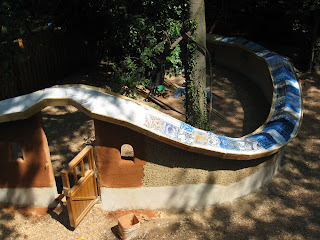One of the big elements of my current project (which is at this point invisible) is that the intention is to achieve code-approved, permitted status. In fact, if I were to fail in this regard, the project would simply not happen, as my building lot is in an urban (i.e. visible) area.
I have been very slowly working to collect together what I hope are the necessary plans for a building permit (utilities will come soon after). I am using a combination of Google Sketchup (free) and the trial version of Adobe Illustrator CS5 (free, but limited to 30 days) to create this document. It is a healthy mix of renderings, boring cross-section diagrams on rigid graphs, and graphic icons.
Below is a generous sample (everything but a couple of redundant diagrams):
One of the nice things about Sketchup is that it allows you to view your model with different styles. Here is a three-quarter view in "pencil on light brown:"
The foundation has one open wall so that I will be able to store materials underneath the house, and crawl in to access plumbing and gas utilities. The reason that the foundation sticks out past the edge of the building by 8 feet is because I am planning ahead for a porch addition.
The framing for this part of the house is conventional for two reasons: 1. in an attempt to get a permit quickly, and 2. I will able to build it super-fast, (and deal with my guilt later). In short, I need a place to live this winter, and winter is right around the corner.
The very simple floor plan:
Diagrams, diagrams, diagrams. It took me a while to figure out how to do these. I wanted them to be digital, so that I could easily e-mail them, print them, integrate them into documents along the way, and - most importantly - modify them. I couldn't find a way to get a tight enough output using Sketchup - the renderings are really loose and (you guessed it) sketchy. So I ended up creating them from scratch in Illustrator, which looks tight, but is time-consuming and frustrating at times. Any software suggestions would be appreciated.
I have to give credit to my good friend Dan at
Stony Creek Farm for the following drawing. I really love the simple, iconic schematic that he drew up for
his house, and appreciate his generosity in sending it to me as a reference. It's a really elegant explanation of the plumbing. For the record, I didn't actually "steal" any of his document, but made it all myself in Illustrator - but the value is in the idea, and it's a good one.
I'm going to take everything into the city tomorrow, and see what happens. The experiment here has nothing to do with natural materials (I wanted to save that battle for much later); instead, it's just an attempt at a permit by someone who has no training in conventional construction. I have involved no engineers, no architects, and no professional builders.
For clarification, this little rectangular structure is just the beginning of my project - just enough to give me a place to live with a bathroom, kitchen, and sleep spot. The meat of the project will come as an addition to this building next season, and will be full of mud, strawbales, rough-hewn timbers, and passion.



















































